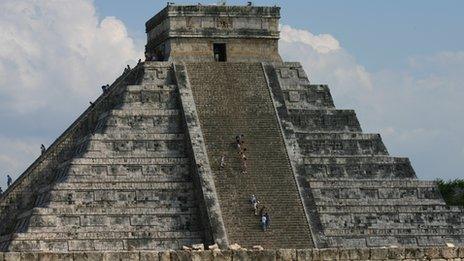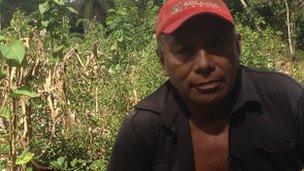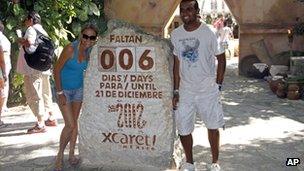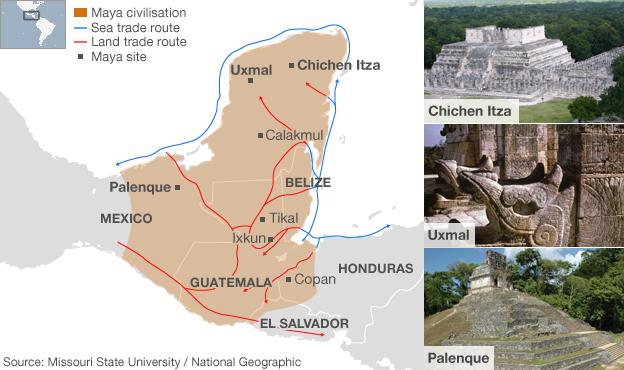Mexico seeks 'end of world' Maya tourism boost
- Published

Chichen Itza was one of the biggest cities in the Maya world
Chichen Itza was one of the jewels in the crown of the Maya empire. The magnificent Pyramid of Kukulkan was the centrepiece of a civilisation that at its height stretched across Central America and southern Mexico.
Today Chichen Itza is a Unesco World Heritage Site, and receives more than a million visitors a year.
This year, tourist numbers are expected to reach record levels as people flock to Yucatan state in Mexico to see the ruins before, as one advertising slogan put it, "it's too late".
It is a reference to a popular belief that the Maya predicted the end of the world on 21 December 2012. For some, given the state of the world economy, the idea of an imminent apocalypse seems distinctly plausible, almost attractive.
But for modern-day Maya, selling their handicrafts in the shadow of the temple, it is all just a big misunderstanding.
"It's not the end of anything," says stall-owner Isidro Ek'mato, pointing out the date on a Maya calendar he whittled out of Cypress wood.
Rather, he explains, it is the start of a new calendar cycle of five millennia.
Mr Ek'mato says his grandfather taught him the intricacies of the calendar and indicates how the different periods of time are all represented on the Kukulkan pyramid.
If anything, Mr Ek'mato says, it is a privilege to be here to witness the start of a new cycle.
Stall-owner Isidro Ek'mato explains how to read the Maya calendar
The misconception about the "prophecy" of the end of the world is not the only myth circulating about the Maya. Many believe they were somehow wiped out shortly after the arrival of the Spanish conquistadors.
In fact, the descendants of the people who built Chichen Itza are still here. They are the second largest ethnic group in Mexico, with between 800,000 and a million native Mayan speakers.
They are also some of the poorest, most marginalised people in the region.
In the small village of Tahdziu, times are tough. Traditional activities like agriculture are arduous and poorly paid.
Indigenous farmer Juan Bautista Itza Mai has been working the fields for more than half a century, using the same farming methods as his ancestors. And he speaks the same ancient Mayan language.
"I won't lose the Maya culture nor language," he tells us through a translator.
"My first words were in Mayan and I only speak a handful of words in Spanish. So I won't lose it."
His sons are mainly farmers too. "They were welcome to do other things if they wanted," he says about the temptation of heading north to the US.
"But I could only teach them this," he says, pointing to the arid cornfields on his small parcel of land.
Many of the women in Tahdziu survive by selling the ornate fabrics they sew by hand.
"Our costs have gone up but we don't get any more for our dresses," one of the women explains. No one in the village has seen a single extra peso out of the tourism boom in the area, nor do they expect to, they say.
In the state capital, Merida, it is a different story. A multi-million dollar museum of indigenous culture has been built as part of the Yucatan state government's 2012 Maya celebrations.

Juan Batista is from a long line of Maya farmers
It is a stunning collection of artefacts and interactive exhibits in Mayan, Spanish and English. But the museum has generated controversy, particularly for its cost. The director, Jorge Esma, says it was money well spent.
"This is a space like the Maya built," he says, comparing it to the temples at Palenque or Uxmal.
"I'm sure the ancient Maya also had conflicts over decisions whether to build those great monuments to leave us their legacy. Well, we're doing the same thing."
But that is not an argument that convinces the government's critics.
They say the Maya 2012 celebrations - involving poetry, music and dance festivals at sites like Chichen Itza - have done nothing to benefit the local indigenous communities.
"I think it's going to be like a hangover," says sociologist Cristina Munoz of a local human rights group, Indignacion.

Party like it's, well - not the end of the world
"A hangover after a badly organised party for which the Maya were just the pretext. They didn't organise it nor interpret it. They're just being used like a show at a party of the rich. "
"All that's left to do after a party like that", she adds ruefully, "is pick up the rubbish."
Back at Chichen Itza, Mr Ek'mato has had a rough day trying to sell his wooden Maya calendars.
"Very few people are buying," he says. "I think it's because of the economic crisis. It's affecting us too. Sometimes we can go three or four days without selling anything."
But the Maya are a resilient people, who have survived innumerable crises since the arrival of the conquistadors.
Some may see 21 December as the end of time; the Maya say it is the start of a new dawn.

- Published2 December 2011
- Published29 June 2012
- Published10 May 2012